Traditional macarons are made with almond flour, but I have too many friends with nut allergies to not come up with versions they can eat. Many nut-free macarons use whole wheat flour or coconut flour, but gluten and coconut are also common allergies. This super simple macaron recipe uses oat flour making these delicious bite-sized nut-free and gluten-free treats taste like Oatmeal Creme Pies!
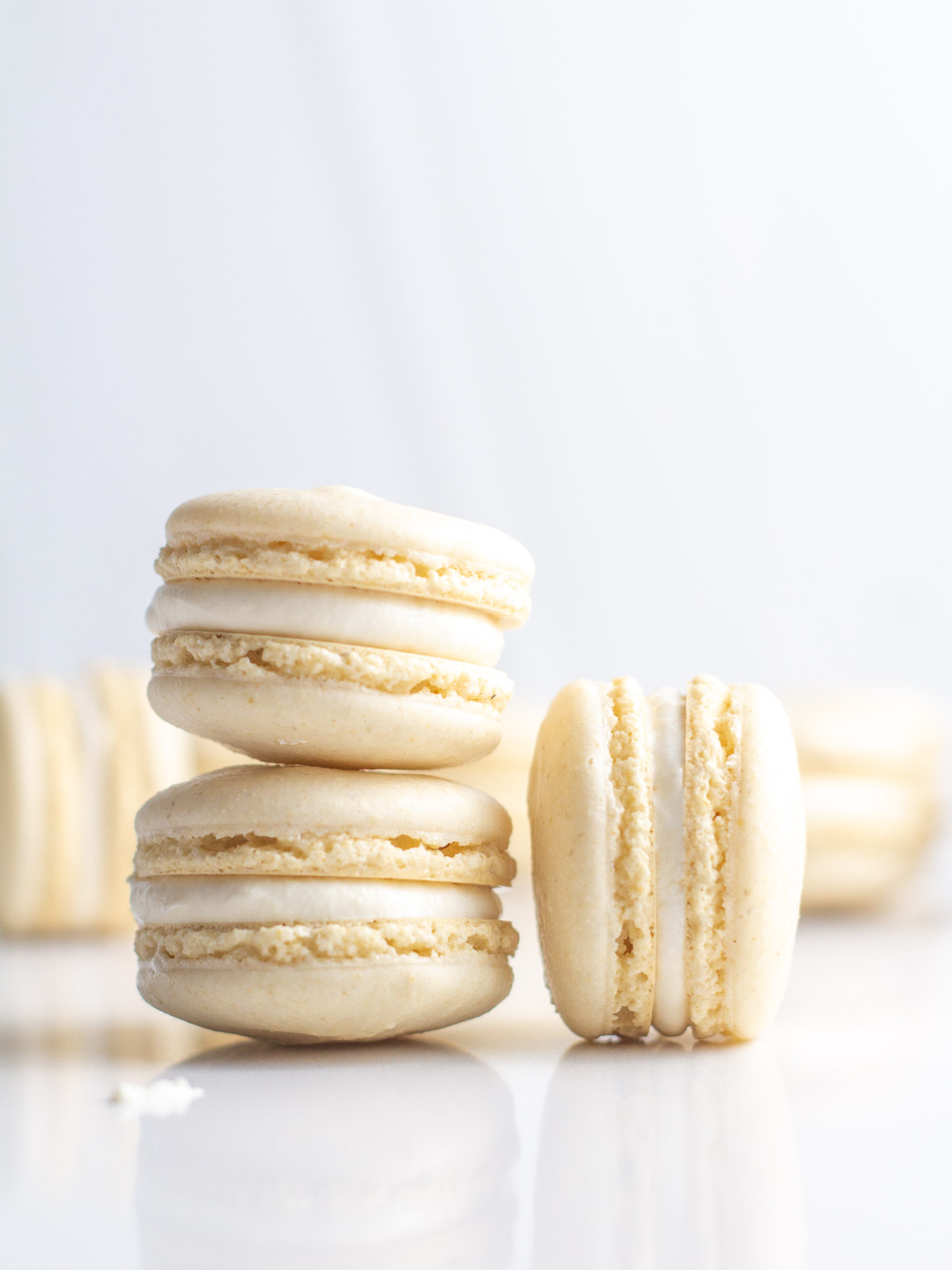
These oat flour macarons make tasty gifts. And even though these treats are nut-free and gluten-free, they're so good that you won't miss the almond flour! Whether you're looking for allergy-friendly dessert options or not, these Meringue Cookies and this Cookie Cake are also easy go-to recipes that are also gluten-free and nut-free, and will be loved by everyone!
Why this Recipe Works
Almond flour primarily contributes to the flavor and texture of a traditional macaron. When using oat flour instead, you definitely can taste a nice, subtle oat flavor which, when combined with the marshmallow filling, gives off Oatmeal Creme Pie vibes.
Oat flour still gives these nut-free macarons a chewy texture, like almond flour does for traditional macarons. Oat flour macarons also still grow feet. Feet are the textured platform underneath the smooth tops of macarons, which is what you want to see when the macarons are baked.
Ingredients and Notes

Oat Flour - This is the key ingredient in this nut-free macaron recipe in terms of both flavor and texture. Oat flour can be purchased or can be made by grinding oats in a food processor.
Egg Whites - Whipping egg whites into meringue creates the light and airy texture of these oat flour macarons. This works best when the egg whites have been brought to room temperature. Aging your egg whites, or letting them sit outside the shell for at least a few hours is ideal. Some bakers age them for 24-48 hours.
Cream of Tartar - You can whip egg whites into meringue without adding cream of tartar, but cream of tartar helps stabilize them. A bit of an extra assurance that you'll get stiff peaks every time!
Substitutions
Oat Flour - I have recipe tested nut-free macarons with multiple flours and each has different elements that impact flavor, texture, and measurements. I would not recommend substituting for a different flour for this oat flour macaron recipe or you'll lose the oatmeal cream pie flavor. Additionally, swapping flours will require different measurements so if you are looking to use a different flour, I would recommend finding a recipe that makes nut-free macarons with the type of flour you want to use.
Egg Whites - To make the shells without eggs, aquafaba can be used instead. Aquafaba is the liquid in the can of chickpeas and is a go-to vegan egg white replacement.
How to Make this Recipe

Step 1: Line a baking sheet with parchment paper or silicone baking mat and prepare a piping bag with a larger round tip.
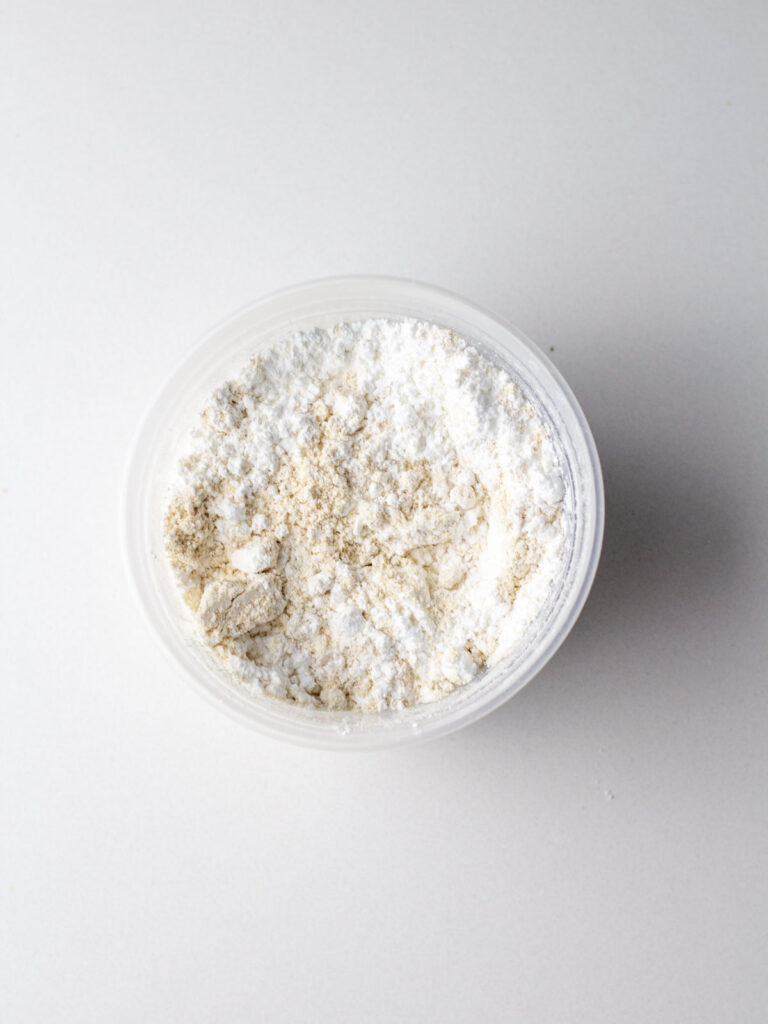
Step 2: Combine oat flour and powdered sugar. Sift or stir with a fork to break up clumps, and set aside.

Step 3: Using the whisk attachment of a stand or hand mixer, begin beating egg whites at medium speed. When they become foamy, add cream of tartar.
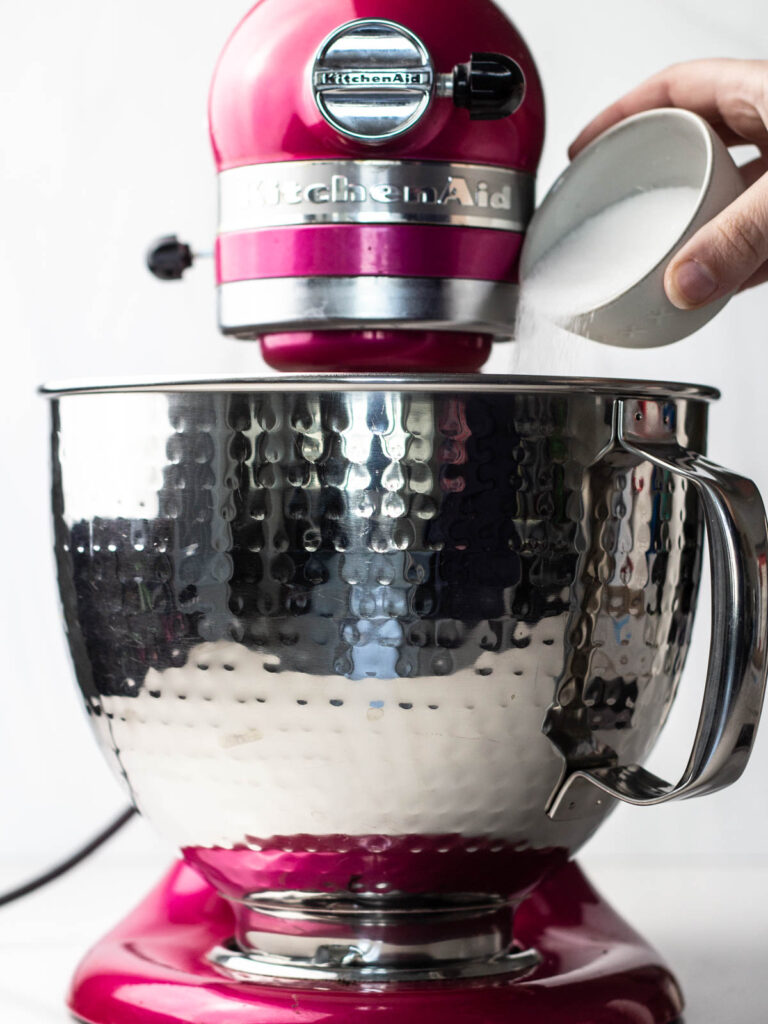
Step 4: Continue beating on medium, and once you start to see the whisk leaving a pattern in the foaming egg whites, slowly and gradually add in the granulated sugar.

Step 5: Once all the granulated sugar is added, turn mixer up to high speed and beat until stiff peaks form.

Step 6: Add the oat flour/powdered sugar mixture to the stiff egg whites, and mix with a spatula by running the spatula around the outside edge of the bowl, and going underneath the egg whites to gently fold them over.

Step 7: As you continue doing this, you'll notice the batter will start to loosen up. Once you get to the point where the batter falls off the spatula smoothly, but still breaks, it's ready to go! (This is just before you reach the figure-8 stage that most macaron recipes call for.)
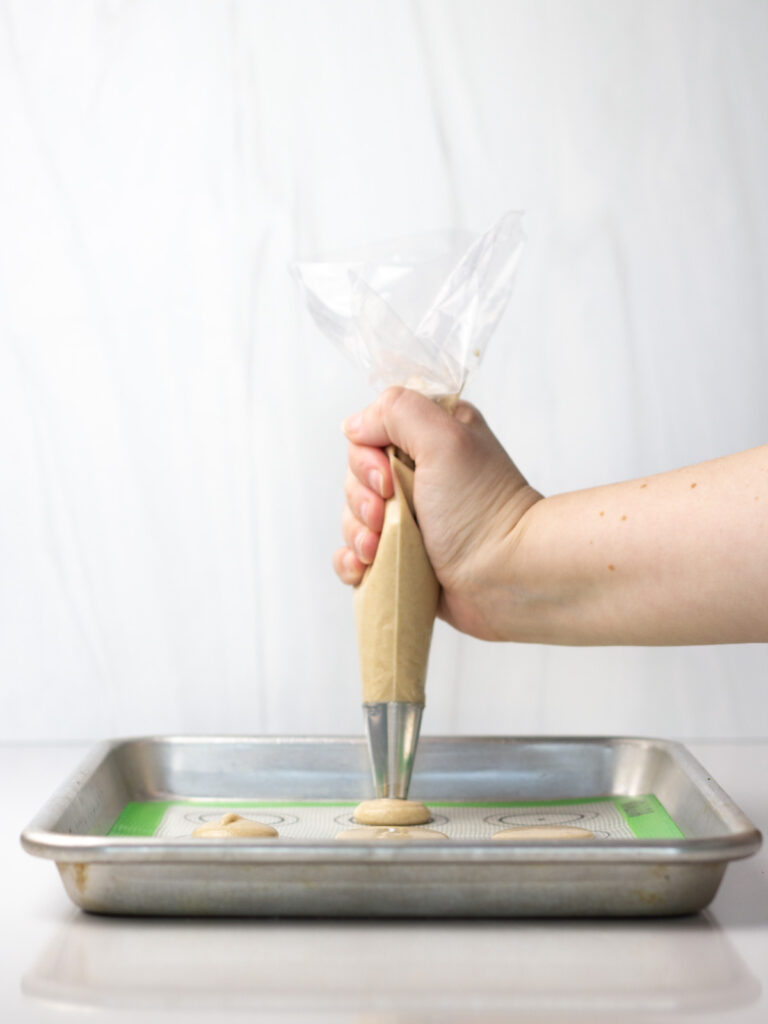
Step 8: Fill the piping bag with the batter. Holding the piping bag straight up and down over a baking sheet lined with parchment paper or a silicone baking mat and squeeze the piping bag for 2-3 seconds to pipe small round circles of batter at least an inch apart.

Step 9: Once the batter is all piped or the pan is full, bang the pan on the counter or floor a few times. You do not need to be gentle here. This is to get all the air bubbles out of the batter. Let the batter sit on the pans for at least 30 minutes.

Step 10: Preheat the oven to 300 F. When the batter is ready, you should be able to touch the tops of the macarons and they should feel dry and not sticky. Bake for 15-18 minutes. Let the macarons cool complete on the pan.
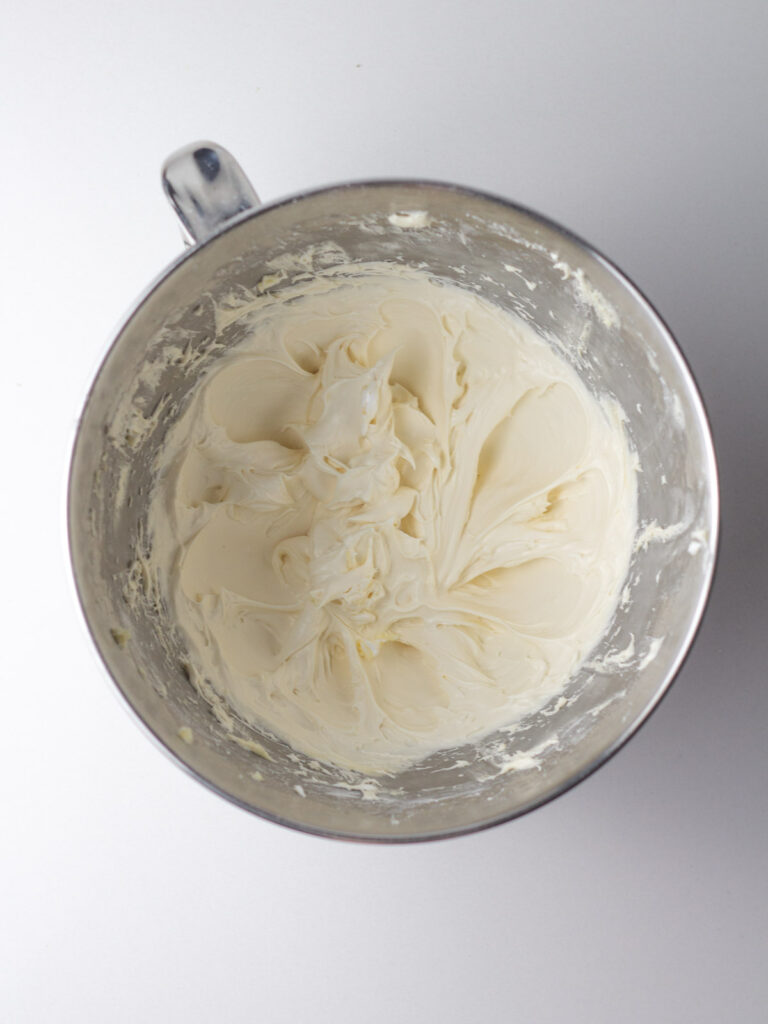
Step 11: Beat butter until soft and fluffy. Add in remaining ingredients, and beat until smooth. Place in piping bag.

Step 12: Once macarons have fully cooled, pair similar-sized shells together. Holding the piping bag vertically over the bottom of one shell in a pair, squeeze bag for 2-3 seconds. Place the bottom of the other shell in the pair onto the icing. Repeat for each pair.
Recipe FAQs
There are many nut-free macaron recipes available without almond flour. I am particularly fond of making macarons with oat flour because of the delicious flavor it adds, but you can also find nut-free macaron recipes with all-purpose or whole wheat flour or coconut flour as well. I highly recommend finding a recipe that calls for the kind of flour you want to use, and not making flour substitutions to a macaron recipe.
Humidity can lead to wet and sticky macarons. It's best to bake them on a low-humidity day, but if you absolutely have to bake them on a humid or rainy day, your best bet is to let them rest for a longer period of time before baking.
A macaron is a light and airy sandwich cookie made with whipped egg whites. They are smooth, fragile, soft, and slightly chewy. A macaroon is a mound of coconut, sometimes dipped in chocolate. It's dense, rough, and chewy. Two very different cookies, but both delicious!
No! They can definitely be finicky, but they are so much easier than you'd expect. And even a batch doesn't turn out quite right, they will still taste delicious every single time. And the more you make them, the more you'll get the hang of it!
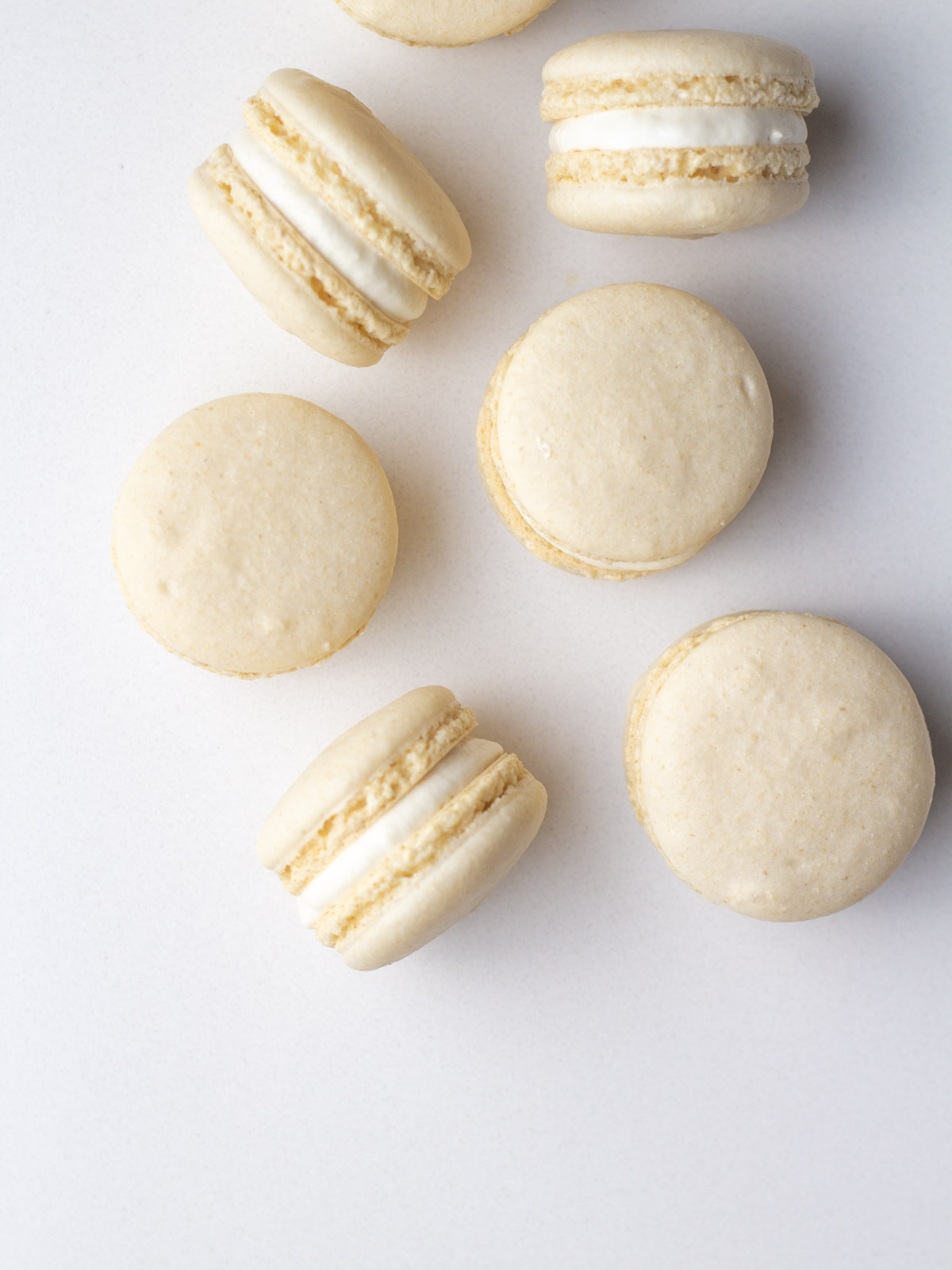
Tips & Tricks
Tip #1: To determine if your egg whites are ready, stick the whisk straight down into the mixture and pull it straight out. If the egg whites stand straight up in a peak, it's ready! Stop your mixer as needed to check the peaks to avoid over-beating.
Tip #2: When folding the oat flour into the egg whites, you'll want to fold it very gently. You will deflate some of the egg white as you mix, but you don't want to deflate it completely. The air whipped into the egg whites is what gives macarons a light and airy consistency.
Tip #3: Most macaron recipes call for mixing the batter until the batter forms a steady ribbon with which you can draw a figure-8 with the batter as it's running off the spatula without any split in the batter. If you reach the figure-8 stage with this batter, your macarons will still be delicious, they will just be a bit wrinkly on the tops of the shells. If you stop folding the batter just ahead of the figure-8 stage, where the batter flows off the spatula, but breaks some, you'll get perfectly smooth shells!
Tip #4: Macaron batter tends to be a bit runny which can make it tricky to fill your piping bag. Holding the piping bag with the tip down and the bag's opening up, fold the tip up so the opening of the tip is pointing up. Place the bag into a cup, and fold the top opening of the piping bag over the edge of the cup. This holds the opening of the piping bag open, making it easier to fill, and the tip folded up keeps the batter from leaking out.
Storage Tips
Oat Flour Macarons can be stored in an airtight container at room temperature for about a week.
Related Recipes
Did you try this recipe? Leave a review below, and tag @flourdeliz on Instagram!
📖 Recipe
Nut-Free Macarons
Equipment
- Hand or stand mixer with whisk attachment
- Piping bag or Ziplock bag and piping tip
- Kitchen scale
- 2 mixing bowls
Ingredients
Macaron Shells
- 50 grams egg whites at room temperature
- 45 grams sugar
- ⅛ teaspoon cream of tartar
- 63 grams oat flour
- 63 grams powdered sugar
Filling
- 2 tablespoons butter
- 2 tablespoons powdered sugar
- ½ teaspoon vanilla
- ¼ cup Marshmallow Fluff
Instructions
Macaron Shells
- Line a baking sheet with parchment paper or silicone baking mat.
- Prep a piping bag with a larger round tip. I use Wilton 2A.
- Combine oat flour and powdered sugar, and set aside.
- Beat egg whites on medium speed until foamy.
- Add cream of tartar, and continue beating until you start to see a pattern from the whisk in the foam.
- Slowly and gradually add the sugar while still beating.
- Once all the sugar is added, turn the mixer up to high speed and beat until the egg whites form stiff peaks.
- Add the oat flour mixture to the egg whites. Stir by running a spatula around the edge of the bowl, and under the egg whites, folding over.
- Continue doing this until the batter falls off the spatula, with some breaking, just before the figure-8 stage that most macaron recipes call for.
- Add the batter to a piping bag, and pipe onto the lined baking sheets about an inch apart.
- Bang the baking sheet on the counter or floor to release any air bubbles.
- Let rest for 30 minutes.
- Preheat the oven to 300 F.
- Bake for 15 minutes. Let cool on the pan completely.
Filling
- Beat butter until light and fluffy.
- Add remaining ingredients and beat until desired consistency.
Assembly
- Pair similar sized shells.
- Pipe the filling onto the bottom of one shell in each pair.
- Place the bottom of the other shell onto the piped frosting, forming a sandwich.
Notes
Nutrition
This recipe was originally posted on May 31, 2021, but was republished with new photos and additional information about the recipe in June of 2023.











AmyT says
So clever and sounds yummy! I've been making macarons for almost a month now and it's so much fun. I'll have to try this one too! Thanks
Liz Pollio says
I'm so glad you've discovered the enjoyment in macarons! I think they're fun too! This is a great one for something a little different, but still delicious! I can't wait to hear how it goes!
Jazmine says
Hi. I stumbled upon your recipe recently and for the first time I was actually able to make macarons successfully. So now I’m curious about flavoring the macarons cookies themselves. Is that possible with this recipe. For instance if I wanted to make chocolate macarons is it possible with this recipe to add like coco powder to make them chocolate or do you just recommend experimenting with fillings instead of the cookies themselves?
Liz Pollio says
Hi Jazmine, I'm so glad it was a success for you! Making changes like adding cocoa powder will impact the texture of the macarons, so other ingredients would need to be adjusted to account for the increase in dry ingredients. It's certainly something you can experiment with, but I expect that the fillings will be easier to adjust. If you do try out some variations, I would love to hear how they turn out!
Julia says
I've made two batches of these weighing everything out. Both batches came out significantly thicker than the photos BUT they still baked really well and were great. The first batch I used the cream of tartar and it actually didn't turn out as well or smoothly as the second batch, but maybe that's a coincidence. my partner is allergic to tree nuts, and we have a friend allergic to gluten, so we're very grateful for this recipe!!
Liz Pollio says
Thanks so much for trying these, Julia! Did the batter come out thicker, or the macaron cookies themselves? If it's the batter, continue folding! It's pretty thick at first, and it takes longer than you might expect, but it will loosen up if you continue to fold! If it's the cookies, this is based on how you pipe them out. They will spread some while the rest, but if the batter is thicker then it won't spread as much resulting in thicker cookies. I hope this helps!! I'm glad this recipe has come in handy and hope you continue to enjoy!